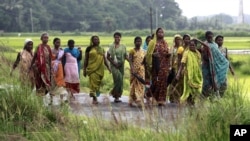NEW DELHI — India is bracing for a drought in parts of the country, as monsoon rains continue to be scant. It is expected to hit food production and bring hardship to millions of farmers in the country.
Satnam Singh Behru was cheerful as he planted paddy seeds in mid-June on his seven-acre farm in Patiala district in the northern Punjab state - known as India’s bread basket. The weather office had forecast a normal monsoon, raising hopes of a plentiful harvest.
But, six weeks on, Behru is worried. Monsoon rains have been erratic.
He says he has to pump water from underground wells to prevent the saplings from withering. But his village gets power for only a few hours a day, so he has been buying diesel to run generators. That adds huge costs.
Behru has drastically scaled down expectations of his crop yield and his income.
Monsoon rains, which irrigate more than half of India’s farms, have been deficient by 20 percent. Some key food-producing regions have fared worse, not even getting half the normal rains.
Farmers are staring at parched fields in Gujarat and Maharashtra and in the southern states of Andhra Pradesh and Karnataka. These are top producers of cotton, oilseeds and sugar - all crops sown in the summer season.
Prime Minister Manmohan Singh has said the government is ready to address the situation. The government says it is increasing the supply of electricity and diesel to northern states. Farmers are being given high yielding seeds to replant their fields.
India’s huge buffer stocks of wheat and rice also mean that the availability of food grain will not pose a problem, despite low production.
The weather office also gave some cause for optimism on Thursday, saying rains will improve in the coming days.
Still, worries are mounting about the impact of the erratic monsoon. Although the farm sector accounts for just 15 percent of India's gross domestic product, it sustains two-thirds of the nation's 1.2 billion people.
Farm analyst Devender Sharma, in New Delhi, says some of the parched regions, such as Madhya Pradesh and Rajasthan, have a high incidence of poverty.
“The year of drought means that the rural economy goes back by at least three years. Which means the brunt is being borne by the farmers. That is a cause for worry. It reduces the average income. Their entire economic cycle is dependent upon what happens in the monsoon season,” said Sharma.
Food inflation, already high, is expected to rise further if the monsoon does not revive next month.
The government has also said it will review its export rules for farm goods next month. India is the world’s second largest producer of wheat, rice and sugar. Lower production could prompt a ban on exports.
Satnam Singh Behru was cheerful as he planted paddy seeds in mid-June on his seven-acre farm in Patiala district in the northern Punjab state - known as India’s bread basket. The weather office had forecast a normal monsoon, raising hopes of a plentiful harvest.
But, six weeks on, Behru is worried. Monsoon rains have been erratic.
He says he has to pump water from underground wells to prevent the saplings from withering. But his village gets power for only a few hours a day, so he has been buying diesel to run generators. That adds huge costs.
Behru has drastically scaled down expectations of his crop yield and his income.
Monsoon rains, which irrigate more than half of India’s farms, have been deficient by 20 percent. Some key food-producing regions have fared worse, not even getting half the normal rains.
Farmers are staring at parched fields in Gujarat and Maharashtra and in the southern states of Andhra Pradesh and Karnataka. These are top producers of cotton, oilseeds and sugar - all crops sown in the summer season.
Prime Minister Manmohan Singh has said the government is ready to address the situation. The government says it is increasing the supply of electricity and diesel to northern states. Farmers are being given high yielding seeds to replant their fields.
India’s huge buffer stocks of wheat and rice also mean that the availability of food grain will not pose a problem, despite low production.
The weather office also gave some cause for optimism on Thursday, saying rains will improve in the coming days.
Still, worries are mounting about the impact of the erratic monsoon. Although the farm sector accounts for just 15 percent of India's gross domestic product, it sustains two-thirds of the nation's 1.2 billion people.
Farm analyst Devender Sharma, in New Delhi, says some of the parched regions, such as Madhya Pradesh and Rajasthan, have a high incidence of poverty.
“The year of drought means that the rural economy goes back by at least three years. Which means the brunt is being borne by the farmers. That is a cause for worry. It reduces the average income. Their entire economic cycle is dependent upon what happens in the monsoon season,” said Sharma.
Food inflation, already high, is expected to rise further if the monsoon does not revive next month.
The government has also said it will review its export rules for farm goods next month. India is the world’s second largest producer of wheat, rice and sugar. Lower production could prompt a ban on exports.








